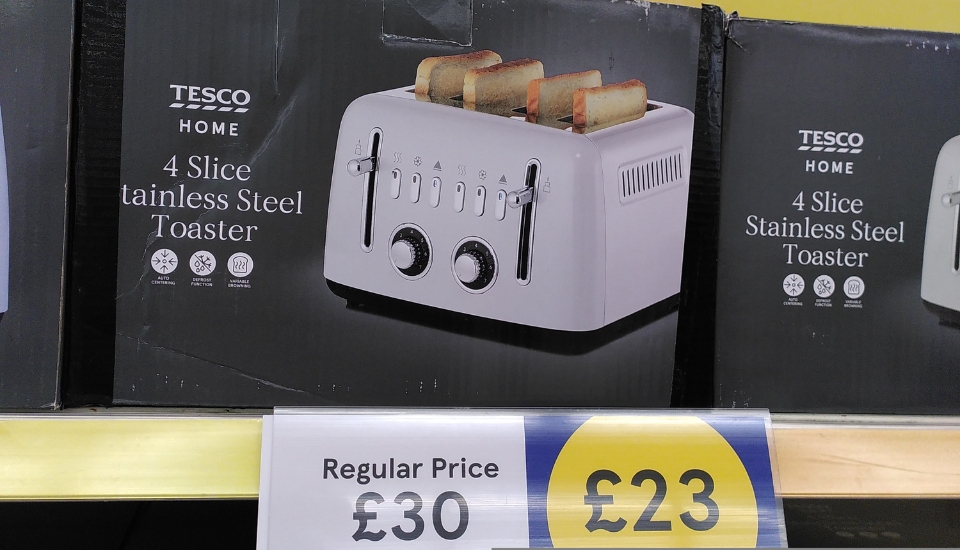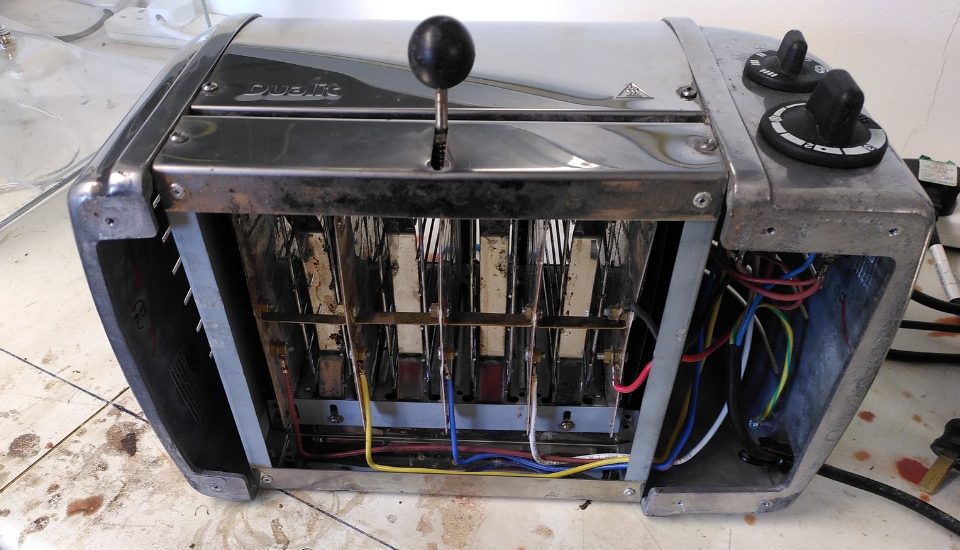We need to think much more about the long-term costs of how and what we consume, argues Moray MacPhail. He offers a tale of two toasters to demonstrate the trade-offs that need to be considered.
This is the first in our Comment spotlight series where we highlight the most engaging articles submitted to the Comment space on Circle. If you have an article you'd like to share with other Fellows, click the link to upload it now.
It was the best of designs, it was the worst of designs, it was the age of feature-rich products, it was the age of minimalism, it was the epoch of smart…
OK, that’s probably enough pseudo-Dickens for now. A couple of toasters coming through the Suffolk Repair Shed raised some interesting dilemmas regarding design and consumer choice.
The Repair Shed is a non-profit organisation, staffed by volunteers with the aim of repairing faulty household items rather than sending them to landfill. And the two toasters in question are the KitchenAid Artisan Toaster and the Dualit 40378 Combi.

Comment spotlight
Are you an RSA Fellow? Submit your original article to Circle and it could be featured as the next Comment spotlight.


Toaster test
Looking first at the KitchenAid, the manufacturer states: “The 2 Slice – Artisan toaster 5KMT2204 offers the ultimate toasting experience. It not only looks curved and stylish, but has a die-cast metal construction and offers every feature you could want. This is an automatic toaster, which means the Auto Sensor lowers and lifts for you... Which of the stunning colours will you choose to match your interiors?”
And from an online review: “It’s not just the KitchenAid’s looks that will turn heads, the features will wow too. For example, put bread in the slots and the toaster automatically senses them, lowers them and starts toasting.
When your toast is done, the KitchenAid lifts it up in the slot… but if it’s not removed within 45 seconds it automatically lowers and goes on a keep-warm cycle for three minutes.
So far, so many bragging rights, but what about the results? It beeps at the start and finish, sounds like an elevator reaching its desired floor. Which seems fitting, as the bread is lifted up and down.”
It costs between £150 and £270 in the UK today.
Contrast that with the Dualit. Again, from the manufacturer's website: “We are proud that every Classic Toaster is handmade in the UK by our skilled craftsman. Quality and attention to detail are paramount, which is why each toaster features the assembler's name on the base plate. It offers all the styling and functionality you would expect from a Dualit toaster... The energy-efficient slot selector control allows you to heat one, two or all four slots.”
Product features (selected):
- Award-winning ProHeat elements, guaranteed for two years
- Handmade in the UK
- Mechanical timer
- Manually operated eject lever to keep items warm until needed
- Replaceable parts (you don’t throw a Dualit toaster away, we repair it for you!)

This toaster retails for between £170 to £220. At around £200 each, the toasters are both expensive by any measure.
If you are the lucky possessor of a Tesco Clubcard, you can get a new stainless steel pop-up four-slice toaster for £23. So why on earth would you pay eight times that for one of these?
(There are many similar offerings from other retailers – I just happened to be in Tesco this morning.)
Simplicity vs complexity
What you are paying for with the Dualit is – perhaps perversely – simplicity. There are few parts and they are made from good quality and substantial materials. It is all held together with conventional fasteners. Part of the sales pitch is that parts are available. We typically see them in the Suffolk Repair Shed after 10 to 20 years, often needing a new timer. Fit that, and it’s good for another 10 to 20 years.
Once it has depreciated to about £100, it keeps its value, and there are plenty of used ones at around that price in both the UK and US.


Inside the KitchenAid, however, there is complexity. Yes, there is style and sophistication – your toast glides out of the machine, only to disappear again if you aren’t quick enough to collect it. But the sophistication comes at the cost of complexity – described by one of our repairers here as “laughably complex”.
From the consumer’s perspective, there is a five-year warranty, so if it does break you can get another. If it’s out of warranty, however, the snag is that spares are not readily available, so after an estimated lifespan of five to 10 years, that’s it off to the tip. It is noticeable that there aren’t many used ones for sale in UK or the US on Ebay.


Through-life costs
So back to the Tesco’s £23/£30 offer. Will the toast be eight times worse than the others? That’s unlikely, unless you insist on burning it. Will the toaster last eight times less than the others? Compared with the KitchenAid that would mean a life of between 10 and 20 months, which is improbably short for any toaster.
Compared with the Dualit, that would mean a lifespan for the cheaper toaster of around 2.5 to five years which is fair. But there are many used examples at around £70-£120, around three to four times the Tesco offering. Will the toast be three times as good? Still unlikely. Will it last three times as long? Probably. Will you still be able to get spares in 20 years’ time? Likely. Will it have a residual value once you have finished with it? Probably.
Even if it has to be scrapped at end of life, the simple, high-quality components come apart readily for recycling.
It illustrates how failing to think about or bear the long-term cost of how and what we consume impacts on our current problems
If it just toast you want, then it’s clear – at least while manufacturers don’t have to bear the through-life costs of their products – that both the Tesco offering and the Dualit are good value, though at very different price points.
By that measure, the KitchenAid is not good value. The additional appeal presumably resides in the “stunning colours... to match your interiors” and the “bragging rights”. Which is fine, but such choices don’t bear their full through-life costs. And that’s the thing.
This is a tiny example, but it illustrates how failing to think about or bear the long-term cost of how and what we consume impacts on our current problems. We are all – manufacturers, governments, designers and consumers – to blame for the current situation, and therefore also able to take action. But carry on like this and we’ll all be toast.
Moray MacPhail is a designer, engineer and repairer. This article was first published on Circle, the RSA’s community platform.

Become an RSA Fellow
The RSA Fellowship is a unique global network of social innovators enabling people, places and the planet to flourish. We invite you to be part of this change.
Related Comment articles
-
Ten ways to improve planning in the UK
Comment
Steve Newman
Steve Newman offers provocative propositions to modernise the planning system, create affordable and sustainable homes, and offer financial benefits to the government and local communities.
-
Black History Month: Q&A with I. Stephanie Boyce
Comment
Deborah Ajia
The first Black president of the Law Society discusses how she overcame the odds to rise to the top of her profession, and is now helping to drive social change as an RSA Fellow.
-
Keep dancing!
Comment
Barbara Berkeley-Hill
Age should be no barrier when it comes to dance. Barbara Berkeley-Hill discusses how dancing can help older generations feel younger, happier and more connected.




Be the first to write a comment
Comments
Please login to post a comment or reply
Don't have an account? Click here to register.